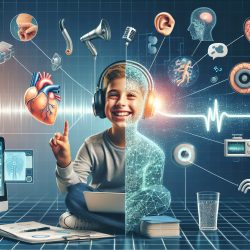As practitioners in the field of speech-language pathology, staying abreast of the latest research and technological advancements is crucial for optimizing patient outcomes. The recent study titled "Neue Wege in der Hrrehabilitation nach Cochleaimplantation" presents innovative approaches in hearing rehabilitation post-cochlear implantation. This blog explores the study's key findings and their practical implications for enhancing teletherapeutic interventions.
Understanding the Need for Digital Rehabilitation
Hearing and speech training post-cochlear implantation has traditionally been conducted in-person, either on an outpatient or inpatient basis. However, with the advent of digital media and a growing demand for mobility and independence, there is a significant shift towards digital training programs. The study highlights the increasing need for such programs, especially in the context of hearing rehabilitation.
Key Elements of the Study
The study identifies the core components of an effective auditory training program based on established auditory and speech processing models. These elements were then integrated into a computer-based teletherapeutic hearing platform called "train2hear." The development process was guided by motivational elements and adaptive mechanisms commonly used in educational and speech therapy.
Initial Analysis and Individualized Training
The cornerstone of the "train2hear" platform is an initial analysis aligned with the International Classification of Functioning, Disability, and Health (ICF). This analysis helps create a personalized training plan for each user. Adaptive mechanisms are employed to continually adjust the difficulty level based on the user's progress, ensuring a tailored and effective training experience.
Teletherapeutic Videotool
A notable feature of the platform is its teletherapeutic video tool, which facilitates real-time interaction between the patient and therapist. This ensures that users receive the necessary support and guidance throughout their rehabilitation journey.
Implications for Practitioners
For practitioners, the "train2hear" platform offers several advantages:
- Enhanced Accessibility: Patients can access rehabilitation services from the comfort of their homes, reducing the need for frequent clinic visits.
- Cost-Effectiveness: Digital platforms can be a more economical alternative to traditional face-to-face therapy sessions.
- Improved Patient Engagement: The use of adaptive mechanisms and motivational elements can increase patient adherence and engagement with the training program.
Future Directions
While the "train2hear" platform shows promise, further clinical studies are necessary to evaluate its applicability and effectiveness comprehensively. Practitioners are encouraged to stay informed about these developments and consider integrating digital rehabilitation tools into their practice.
To read the original research paper, please follow this link: Neue Wege in der Hrrehabilitation nach Cochleaimplantation.










